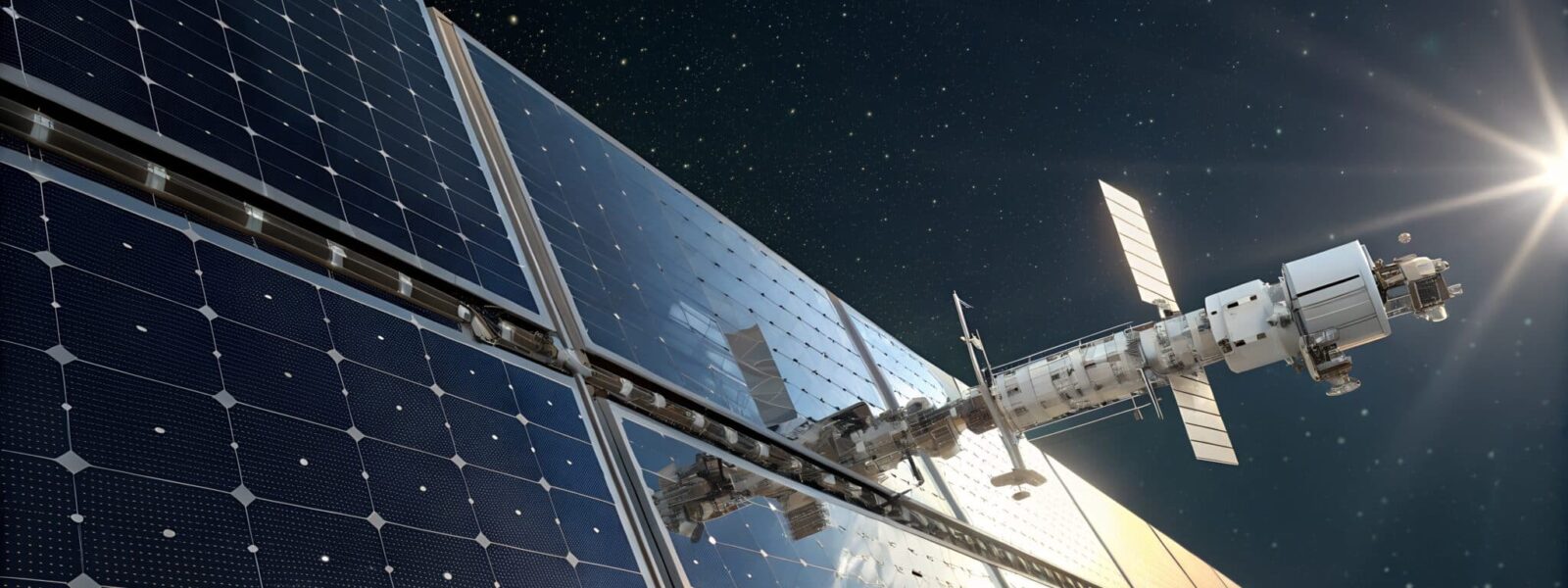Ultra-lightweight, high-performance, foldable: advances in space photovoltaics
- The photovoltaic effect, which harnesses the sun’s rays to generate electricity, is increasingly gaining interest from the space industry.
- Initially, photovoltaic technology was only commercially viable for the space industry, even though the idea of using panels on Earth was already being explored.
- Most satellites orbiting the Earth are now equipped with solar panels, which is the most cost-effective source of energy in space.
- Among the innovations from the space industry that could be used on Earth, photovoltaic technology is one of the most promising.
- Today, the cost of cells for space applications is around €300 per watt, compared to 10–20 cents for terrestrial applications.
What role have satellites played in the democratisation of photovoltaic panels?
Daniel Lincot. The photovoltaic effect was discovered by Edmond Becquerel in 1839. Silicon solar cells were invented before the Second World War by Russell Ohl, and the first patent was filed in 19411. In 1954, the first efficient solar cell was manufactured, achieving an efficiency of 6%. The United States, which was looking to supply satellites with energy, immediately began producing cells for satellites. In 1958, Vanguard 1 was the first satellite sent into space with solar cells. The cost of photovoltaics was extremely high at the time [Editor’s note: In the 1950s, one watt of solar photovoltaic capacity cost £1,865, adjusted for inflation and 2019 prices. Compared to the price in 1956, a solar module today would cost £596,8002, but affordable compared to the cost of launching a satellite into space. The increasing production of solar cells for space applications has led to a decline in costs, which continues today. Without the use of photovoltaics in space, the technology would probably not have developed as quickly.
Why is the space sector so interested in photovoltaic technology?
Loris Ibarrart. Satellites are autonomous objects, particularly from an energy perspective. To carry out their missions, whether for telecommunications, military purposes, or space or Earth observation, they must be able to communicate and to survive. For this they need energy, to send and receive information from Earth, keep equipment at the right temperature and maintain altitude. Finally, the mission itself also requires energy. While Earth observation missions do not consume much energy, telecommunications do. Initially, a battery was placed on board the satellite. Its survival capacity was only a few weeks. Space industry players therefore thought of using the only resource available in space: the Sun.
DL. The first satellite launched into space in 1957, Sputnik, was only able to communicate with Earth for a few weeks! It then remained in orbit around Earth, with no means of communication.
When did photovoltaic panels “come down to Earth”?
LI. From the outset, there was an idea to use photovoltaic panels on Earth, but the technology was only viable for the space industry.
DL. From the 1970s onwards, the first terrestrial applications emerged: equipment for lighthouses and beacons in isolated areas, means of communication in inaccessible locations, and cathodic protection for oil pipelines to limit oxidation. These very specific uses justified the high prices. Then the cost of cells began to fall, particularly following the 1973 oil crisis, which led to an increase in production and therefore a reduction in costs due to economies of scale.
The space industry has evolved considerably since the first uses of photovoltaics in space… is there still a place for photovoltaics today?
LI. The requirements of the space industry remain the same: to produce as much energy as possible on board for the smallest possible mass and volume. Most satellites orbiting the Earth are equipped with photovoltaic panels. Telecommunications satellites have the highest production capacity, which can reach up to around 30 kW, or a solar cell surface area of approximately 100 m2. Only a few missions cannot rely entirely on solar power: probes sent into deep space and rovers [Editor’s note: “astromobiles”, vehicles designed to explore the surface of a celestial body]. They carry a nuclear core, a kind of radioisotope battery. This energy source is more expensive and restrictive than photovoltaics.
DL. Photovoltaics have come a long way, particularly in terms of efficiency, and remain the most efficient source of space energy. The efficiency of the special cells used (multi-junction) can reach 35%. A record efficiency of 47% has been achieved in the laboratory. In comparison, the efficiency of terrestrial silicon cells is just around 25%.
Are innovations in solar power for space useful for terrestrial applications?
DL. The theoretical efficiency of converting photons (light particles) into electricity is 85%. Research is very active in this area, and it is a tremendous avenue for progress for terrestrial applications. Finally, space applications increasingly require very light cells to limit launch costs and facilitate deployment. While terrestrial photovoltaic panels weigh an average of 25 kg per m2, we are working to achieve a weight of 200 g per m2. This is a paradigm shift: photovoltaics are becoming ultra-light, efficient and foldable. On Earth, this opens up a world of possibilities: for example, we can imagine a solar curtain that could be deployed on facades, roofs or in the air. These curtains could also be temporarily deployed over fields after harvest to store electricity. We are working closely with the Ile-de-France Photovoltaic Institute and Ecole Polytechnique’s (IP Paris) interface and thin film physics laboratory, which specialise in these subjects.
LI. We are also at a turning point for space photovoltaics, with a shift from Earth back to space.
To what extent are we at a turning point for space-based photovoltaics?
LI. For about 10 years now, we have seen a growing interest in terrestrial technologies in the space industry. The reason? The rise of satellite constellations, for which the space industry’s economic model is no longer compatible. The requirements here are different: high production capacity, lower cost and lower performance, since redundancy is ensured by the large number of satellites. Today, the cost of cells for space applications is around €300 per watt, compared with 10–20 cents for terrestrial applications. We can imagine a compromise emerging between mass production for terrestrial applications and precision work for space applications, even if the future is uncertain. The challenge is to modify terrestrial cells so that they can operate for as long as possible in space, while making as few changes as possible to existing industrial chains.
So, is this the end of photovoltaic industries dedicated to space?
LI. No, the rise of satellite constellations will not kill off the traditional space solar panel industries. Telecommunications, observation and science will continue to need processes developed specifically for space. Manufacturers have never seen as much demand as they do today.
















